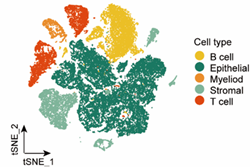Single-cell RNA sequencing reveals cellular dynamics and therapeutic effects of astragaloside IV in slow transit constipation
DOI:
https://doi.org/10.17305/bb.2024.10187Keywords:
Slow transit constipation, astragaloside IV (AS-IV), single-cell RNA sequencing, cellular dynamic, intestinal cellsAbstract
The cellular characteristics of intestinal cells involved in the therapeutic effects of astragaloside IV (AS-IV) for treating slow transit constipation (STC) remain unclear. This study aimed to determine the dynamics of colon tissue cells in the STC model and investigate the effects of AS-IV treatment by single-cell RNA sequencing (scRNA-seq). STC mouse models were developed using loperamide, with subsequent treatment using AS-IV. Colon tissues and feces were collected for scRNA-seq and targeted short-chain fatty acid quantification. We integrated scRNA-seq data with network pharmacology to analyze the effect of AS-IV on constipation. AS-IV showed improvement in defecation for STC mice induced by loperamide. Notably, in STC mice, epithelial cells, T cells, B cells, and fibroblasts demonstrated alterations in cell proportions and aberrant functions, which AS-IV partially rectified. AS-IV has the potential to modulate the metabolic pathway of epithelial cells through its interaction with peroxisome proliferator-activated receptor gamma (PPARγ). AS-IV reinstated fecal butyrate levels and improved energy metabolism in epithelial cells. The proportion of naïve CD4+T cells is elevated in STC, and the differentiation of these cells into regulatory T cells (Treg) is regulated by B cells and fibroblasts through the interaction of ligand-receptor pairs. AS-IV treatment can partially alleviate this trend. The status of fibroblasts in STC undergoes alterations, and the FB_C4_Adamdec1 subset, associated with angiogenesis and the Wingless-related integration (Wnt) pathway, emerges. Our comprehensive analysis identifies perturbations of epithelial cells and tissue microenvironment cells in STC and elucidates mechanisms underlying the therapeutic efficacy of AS-IV.
Citations
Downloads

Downloads
Published
Data Availability Statement
Datasets are available on request: The raw data supporting the conclusions of this article will be made available by the authors, without undue reservation.
Issue
Section
Categories
License
Copyright (c) 2024 Huaxian Chen, Xingyang Wan, Qiulan He, Guozhong Xiao, Yihui Zheng, Minyi Luo, Chaoxin Yang, Donglin Ren, Li Lu, Hui Peng, Hongcheng Lin

This work is licensed under a Creative Commons Attribution 4.0 International License.
How to Cite
Accepted 2024-01-25
Published 2024-01-29









